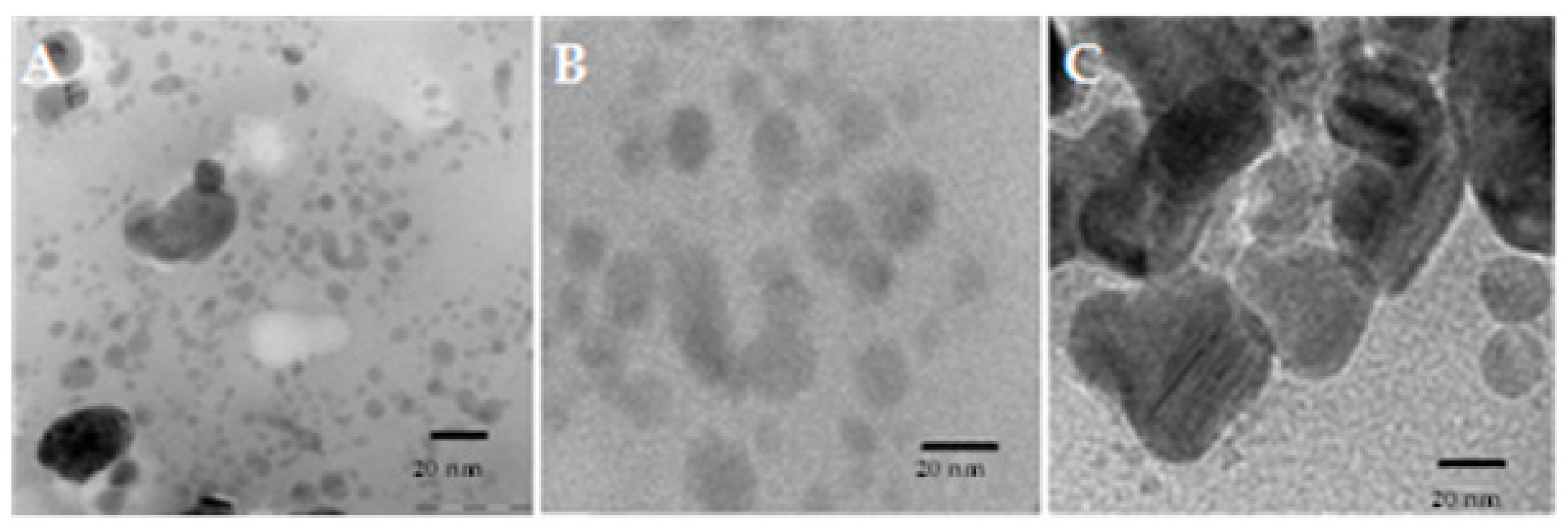Green Synthesis and Characterization of Zinc Oxide Nanoparticles Using Eucalyptus globules and Their Fungicidal Ability Against Pathogenic Fungi of Apple Orchards
Abstract
:1. Introduction
2. Materials and Methods
2.1. Bio-Material Preparation
2.2. Phytosynthesis of Zinc Nanoparticles
2.3. Characterization of Nanoparticles
2.3.1. Detection of Zinc Nanoparticles using UV-Vis Spectrophotometer
2.3.2. Characterization of Zinc Nanoparticles
2.4. Assessment of Antifungal Activity of Zinc Nanoparticles Against Pathogenic Fungi
2.4.1. Fungal Culture
2.4.2. Antifungal Assay
2.5. Measurement of Mycelial Inhibition
2.6. Microscopic Observation of Fungi Treated with Zinc Nanoparticles
2.7. Scanning Electron Microscopy (SEM) of Fungal Mycelium Treated with Zinc Nanoparticles
3. Results and Discussion
3.1. Formation of Zinc Nanoparticles
3.2. UV–Visible Analysis of Zinc Nanoparticles
3.3. Scanning Electron Microscopic study of Zinc Nanoparticles
3.4. FT-IR spectrum of Zinc Nanoparticles
3.5. Antifungal Assessment of Zinc Nanoparticles Against Pathogenic Fungi
3.6. Effect of Zinc Nanoparticles on Fungal Hyphae
3.6.1. Microscopic Observation of Fungi Treated with Zinc Nanoparticles
3.6.2. Scanning Electron Microscopy (SEM) Study of Fungal Mycelia upon ZnNPs Treatment
4. Conclusions
Author Contributions
Funding
Acknowledgments
Conflicts of Interest
References
- Sharathchandra, R.G.; Yatish, N.S.; Jogaiah, S. Aquaporin-Based Nano Biotechnological Materials for Water Treatment and Novel Detection Technologies for Nanoscale emerging Pathogens. Current Advances in Nano Materials; Sharma, S.C., Nagabhushana, H., AnathRaju, K.S., Premkumar, H.B., Eds.; BMSIT, Dayananda Sagar Institutions: Bangalore, India, 2016; pp. 103–107. [Google Scholar]
- Sreenivasa, N.; Meghashyama, P.B.; Udayashankar, A.C.; Lakshmeesha, T.R.; Geetha, N.; Jogaiah, S. Biosynthesis and characterization of Dillenia indica-mediated silver nanoparticles and their biological activity. App. Organomet. Chem. 2020, e5567. [Google Scholar] [CrossRef]
- Joshi, S.M.; De Britto, S.; Jogaiah, S.; Ito, S. Mycogenic Selenium Nanoparticles as Potential New Generation Broad Spectrum Antifungal Molecules. Biomolecules 2019, 9, 419. [Google Scholar] [CrossRef] [PubMed] [Green Version]
- Nandini, B.; Puttaswamy, H.; Prakash, H.S.; Adhikari, S.; Jogaiah, S.; Nagaraja, G. Elicitation of Novel Trichogenic-Lipid Nanoemulsion Signaling Resistance Against Pearl Millet Downy Mildew Disease. Biomolecules 2020, 10, 25. [Google Scholar] [CrossRef] [PubMed] [Green Version]
- Sangeetha, J.; Thangadurai, D.; Hospet, R.; Purushotham, P.; Manowade, K.R.; Jogaiah, S. Production of Bionanomaterials from Agricultural Wastes. In Nanotechnology: An agricultural Paradigm; Ram, P., Manoj, K., Vivek, K., Eds.; Springer Nature, Gateway East, Singapore Pvt. Ltd.: Singapore, 2017; pp. 33–58. [Google Scholar]
- Singhal, M.; Chhabra, V.; Kang, P.; Shah, D.O. Synthesis of ZnO nanoparticles for varistor application using Zn-substituted aerosol OT microemulsion. Materials Res. Bull. 1997, 32, 239–247. [Google Scholar] [CrossRef]
- Padmavathy, N.; Vijayaraghavan, R. Enhanced bioactivity of ZnO nanoparticles an antibacterial study. Sci. Technol. Adv. Mater. 2008, 9, 035004. [Google Scholar] [CrossRef] [PubMed]
- Vayssieres, L.; Keis, K.; Hagfeldt, A.; Lindquist, S.E. Three-dimensional array of highly oriented crystalline ZnO microtubes. Chem. Mater. 2001, 13, 4395–4398. [Google Scholar] [CrossRef]
- Sangeetha, G.; Rajeshwari, S.; Venkatesh, R. Green synthesis of zinc oxide nanoparticles by Aloe barbadensis miller leaf extract: Structure and optical properties. Materials Res. Bull. 2011, 12, 2560–2566. [Google Scholar] [CrossRef]
- Lin, H.M.; Tzeng, S.J.; Hsiau, P.J.; Tsai, W.L. Electrode effects on gas sensing propertiesofnanocrystalline zinc oxide. Nanostruct. Mater. 1998, 10, 465–477. [Google Scholar] [CrossRef]
- Regan, R.O.; Schwarthz, D.T.; Zakeeruddin, S.M.; Gratzel, M. Electro deposited Nanocompositen–p Heterojunctions for Solid-State Dye-Sensitized Photovoltaics. Adv. Materials. 2001, 12, 1263–1267. [Google Scholar]
- Sharma, D.; Rajput, J.; Kaith, B.S.; Kaur, M.; Sharma, S. Synthsis of ZnO nanoparticals and study of their antibacterial and antifungal properties. Thin Solid Films. 2010, 519, 1224–1229. [Google Scholar] [CrossRef]
- Raghupathi, R.K.; Koodali, R.T.; Manna, A.C. Size-dependent bacterial growth inhibition and mechanism of antibacterial activity of zinc oxide nanoparticles. Langmuir 2011, 27, 4020–4028. [Google Scholar] [CrossRef] [PubMed]
- Yamamoto, O. Influence of particle size on the antibacterial activity of zinc oxide. Int. J. lnorg. Materials. 2001, 3, 643–646. [Google Scholar] [CrossRef]
- Kumar, A.; Pandey, A.K.; Singh, S.S.; Shanker, R.; Dhawan, A. Cellular uptake and mutagenic potential of metal oxide in bacterial cells. Chemosphere 2011, 83, 1124–1132. [Google Scholar] [CrossRef] [PubMed]
- Guo, D.; Wu, C.; Jiang, H.; Li, Q.; Wang, X.; Chen, B. Synergistic cytotoxic effectof different sized ZnO nanoparticles and daunorubicin against leukaemia cancer cells under UV irradiation. J. Photochem. Photobiol B. 2008, 93, 119–126. [Google Scholar] [CrossRef]
- Remzova, M.; Zouzelka, R.; Brzicova, T.; Vrbova, K.; Pinkas, D.; Rossner, P.; Topinka, J.; Rathousky, J. Toxicity of TiO2, ZnO, and SiO2 Nanoparticles in Human Lung Cells: Safe-by-Design Development of Construction Materials. Nanomaterials 2019, 9, 968. [Google Scholar] [CrossRef] [Green Version]
- Thilagavathi, T.; Geetha, D. Nano ZnO structures synthesized in presence of anionic and cationic surfactant under hydrothermal process. Appl. Nanoscience. 2014, 4, 127–134. [Google Scholar] [CrossRef] [Green Version]
- Venkatesha, T.G.; Nayaka, Y.A.; Viswanatha, R.; Vidyasagar, C.C.; Chethana, B.K. Electrochemical synthesis and photocatalytic behavior of flower shaped ZnO microstructures. Pow. Tech. 2013, 225, 232. [Google Scholar] [CrossRef]
- Fabián, M.; Tyuliev, G.; Feldhoff, A.; Kostova, N.; Kollár, P.; Suzuki, S.; Saito, F.; Sepelák, V. One step synthesis of nanacrystalline ZnO via cryomilling. Powder Tech. 2012, 235, 395–399. [Google Scholar] [CrossRef]
- Darroudi, M.; Saboun, Z.; Roskuee, R.K.; Zak, A.K.; Kargar, H.; Hamid, M.H.N.A. Green chemistry approach for the synthesis of ZnO nanopowders and their cytotoxic effects. Ceramics. Int. 2014, 40, 4827–4831. [Google Scholar] [CrossRef]
- Zak, A.K.; Majid, W.H.A.; Wang, H.Z.; Yousefi, R.; Golsheikh, A.M.; Ren, Z.F. Optical properties of ZnO/BaCO3 nanocomposites in UV and visible regions. Nanoscale Res. Lett. 2014, 9, 399. [Google Scholar] [CrossRef] [Green Version]
- Muneer, M.B.A.; Chai, P.V.; Takriff, M.S.; Benamor, A.; Mohammad, A.W. Optimization of Nickel Oxide Nanoparticles Synthesis through the Sol Gel Method using Box–Behnken design. Materials Design. 2015, 86, 948–956. [Google Scholar]
- Ramimoghadam, D.; Hussein, M.; Taufiq, Y.H. Synthesis and characterization of ZnO nanostructures using palm olein as biotemplate. Chem. Cent. J. 2013, 7, 71. [Google Scholar] [CrossRef] [PubMed] [Green Version]
- Samat, N.A.; Nor, R.M. Sol–gel synthesis of zinc oxide nanoparticles using Citrus aurantifolia extracts. Ceramics Int. 2013, 39, 545–548. [Google Scholar] [CrossRef]
- Wang, M.H.; Ma, X.; Jiang, W.; Zhou, F. Synthesis of doped ZnO nanopowders in alcohol–water solvent for varistors applications. Materials Lett. 2014, 121, 149–151. [Google Scholar] [CrossRef]
- Bu, I.Y. Effect of Cu concentration on the structural and optoelectronic properties of ZnO:Cu:Al prepared by the sol–gel deposition method. Ceramics Int. 2013, 41, 4042–4049. [Google Scholar] [CrossRef]
- Ozcelik, B.K.; Ergun, C. Synthesis of ZnO nanoparticles by an aerosol process. Ceramics Int. 2014, 40, 7107–7116. [Google Scholar] [CrossRef]
- Gnanasangeetha, D.; Sarala, T.D. One Pot Synthesis of Zinc Oxide Nanoparticles via Chemical and Green Method. Res. J. Materials Sci. 2013, 1, 1–8. [Google Scholar]
- Gao, S.; Jia, X.; Yang, S.; Li, Z.; Jiang, K. Hierarchial Ag/ZnO micro/nanostructure: Green synthesis and enhanced photocatalytic performance. J. Sol. Stat. Chem. 2011, 184, 764–769. [Google Scholar] [CrossRef]
- Shekhawat, M.S.; Manokari, M. Biogenesis of Zinc oxide Nanoparticles using Morinda pubescens extracts and their Characterization. Int. J. Bioeng. Tech. 2014, 5, 1–6. [Google Scholar]
- Rajiv, P.; Rajeshwari, S.; Venkatesh, R. Bio-fabrication of zinc oxide nanoparticles using leaf extract of Parthenium hysterophorus L. and its size-dependent antifungal activity against plant fungal pathogens. Spectrochimica Act. Part A: Mol. Biomol. Spect. 2013, 112, 384–387. [Google Scholar] [CrossRef]
- Singh, R.P.; Shukla, V.K.; Yadav, R.S.; Sharma, P.K.; Singh, P.K.; Pandey, A.C. Biological approach of zinc oxide nanoparticles formation and its characterization. Adv. Mater. Lett. 2011, 2, 313–317. [Google Scholar] [CrossRef]
- Bhat, K.A.; Peerzada, S.H.; Anwar, A. Alternaria epidemic of apple in Kashmir valley. Afr. J. Microbiol. Res. 2015, 9, 831–837. [Google Scholar]
- Jones, A.L.; Aldwinkle, H.S. White rot. Compendium of Apple and Pear Diseases; American Phytopathological Society/APS Press: St. Paul, MN, USA, 1990; pp. 100–102. [Google Scholar]
- Silva, J.; Abebe, W.; Sousa, S.M.; Duarte, V.G.; Machado, M.I.L.; Matos, F.J.A. Analgesic and anti-inflammatory effects of essential oils of eucalyptus. J. Ethnopharmacol. 2003, 89, 277–283. [Google Scholar] [CrossRef] [PubMed]
- Bhuyan, D.J.; Vuong, Q.V.; Chalmers, A.C.; van Altena, I.A.; Bowyer, M.C.; Scarlett, C.J. Phytochemical, antibacterial and antifungal properties of an aqueous extract of Eucalyptus microcorys leaves. South Afr. J. Botany. 2017, 112, 180–185. [Google Scholar] [CrossRef]
- Siramon, P.; Ohtani, Y. Antioxidative and antiradical activities of Eucalyptus camaldulensis leaf oils from Thailand. J. Wood Sci. 2007, 53, 498–504. [Google Scholar] [CrossRef]
- Jogaiah, S.; Kurjogi, M.; Abdelrahman, M.; Nagabhushana, H.; Tran, L.S.P. Ganoderma applanatum-mediated green synthesis of silver nanoparticles: Structural characterization and in vitro and in vivo biomedical and agrochemical properties. Arabian J. Chem. 2019, 12, 1108–1120. [Google Scholar] [CrossRef]
- Shetty, H.S.; Sharada, M.S.; Jogaiah, S.; Aditya Rao, S.J.; Hansen, M.; Jørgensen, H.J.L.; Tran, L.S.P. Bioimaging structural signatures of the oomycete pathogen Sclerospora graminicola in pearl millet using different microscopic techniques. Sci. Reports. 2019, 9, 15175. [Google Scholar] [CrossRef] [Green Version]
- Rather, H.A.; Rajagopal, K.; Shah, A.H.; Bhat, A.H.; Venugopal, K. Study of bio-fabrication of Iron nanoparticles and their fungicidal property against phytopathogens of apple orchards. IET Nanobiotech. 2017, 11, 230–235. [Google Scholar]
- Krithiga, N.; Jayachitra, A.; Rajalakshmi, A. Synthesis, characterization and analysis of the effect of copper oxide nanoparticles in biological systems. Ind. J. Nanosci. 2013, 1, 6–15. [Google Scholar]
- Shekhawat, M.S.; Ravindran, C.P.; Manokari, M. A biomimetic approach towards synthesis of Zinc oxide Nanoparticles using Hybanthus enneaspermus (L.) F. Muell. Tro. Plant Res. 2014, 1, 55–59. [Google Scholar]
- Jeevanandam, J.; Barhoum, A.; Chan, Y.S.; Dufresne, A.; Danquah, M.K. Review on nanoparticles and nanostructured materials: History, sources, toxicity and regulations. Beilstein J. Nanotechnol. 2018, 9, 1050–1074. [Google Scholar] [CrossRef] [PubMed] [Green Version]
- Vanheusden, W.L.; Warren, C.; Seager, H.; Tallant, D.R.; Voigt, J.A.; Gnade, B.E. Mechanisms behind green photoluminescence in ZnO phosphor powders. J. App. Physics 1996, 79, 7983–7990. [Google Scholar] [CrossRef]
- Ashour, H.M. Antibacterial, antifungal, and anticancer activities of volatile oils and extracts from stems, leaves, and flowers of Eucalyptus sideroxylon and Eucalyptus torquata. Cancer Biol. Ther. 2008, 7, 399–403. [Google Scholar] [CrossRef] [PubMed] [Green Version]
- Sawai, J.; Yoshikawa, T. Quantitative evaluation of antifungal activity of metallic oxide powders (MgO, CaO and ZnO) by an indirect conductimetric assay. J. App. Microbiol. 2004, 96, 803–809. [Google Scholar] [CrossRef] [PubMed]
- Eman, M.E.; Ahmed, M.A.; Nagwa, K.; Salwa, F.M.; Samaal, E.D.; Khana, M.A.; Mariam, H.Y. Antifungal activity of zinc oxide nanoparticles against dermatophytic lesions of cattle. Romanian J. Biophys. 2013, 23, 191–202. [Google Scholar]
- Villamizar-Gallardo, R.; Cruz, J.F.O.; Ortíz-Rodriguez, O.O. Fungicidal effect of silver nanoparticles on toxigenic fungi in cocoa. Pesq. Agropec. Bras. 2016, 51, 1929–1936. [Google Scholar] [CrossRef]








| Test Fungi | Inhibition rate (%) | |||||||
| Eucalyptus globulus | Zn ion solution | |||||||
| 10 ppm | 25 ppm | 50 ppm | 100 ppm | 10 ppm | 25 ppm | 50 ppm | 100 ppm | |
| Botryosphaeria dothidea | 10.1 ± 0.3 c | 18.1 ± 1.3 b | 22.4 ± 0.4 b | 27.3 ± 2.4 b | 2.2 ± 0.4 b | 9.5 ± 1.6 c | 13.4 ± 2.5 b | 13.1 ± 0.7a |
| Diplodia seriata | 7.2 ± 2.4 b | 10.5 ± 2.1 c | 11.8 ± 0.2 c | 21.8 ± 2.1bc | 5.2 ± 0.5 b | 12.3 ± 2.5 b | 14.4 ± 1.6 b | 17.9 ± 0.5 b |
| Alternaria mali | 40.9 ± 1.4a | 49.2 ± 2.1 a | 62.82 ± 1.2 a | 78.7 ± 2.4 a | 22.3 ± 1.2 a | 32.8 ± 1.4 a | 36.3 ± 0.5 a | 35.7 ± 2.5 a |
| Test Fungi | Inhibition Rate (%) | |||||||
| ZnNPs | ZnNPs+ Eucalyptus Globulus | |||||||
| 10 ppm | 25 ppm | 50 ppm | 100 ppm | 10 ppm | 25 ppm | 50 ppm | 100 ppm | |
| Botryosphaeria dothidea | 21.1 ± 0.2 b | 46.3 ± 3.2 ab | 60.5 ± 0.4 b | 65.4 ± 0.6 a | 27.1 ± 1.4 b | 50.3 ± 0.2 a | 61.5 ± 1.3 a | 67.1 ± 2.5 b |
| Diplodia seriata | 16.5 ± 0.4 bc | 31.3 ± 1.3 c | 53.1 ± 0.1bc | 55.2 ± 1.2 c | 36.5 ± 1.2 b | 48.3 ± 1.2 ab | 65.3 ± 0.8 a | 66.7 ± 1.3 b |
| Alternaria mali | 36.6 ± 1.4 a | 51.6 ± 1.5 a | 73.5 ± 1.4 a | 76.7 ± 1.4 a | 20.6 ± 0.3bc | 39.6 ± 0.4 c | 53.3 ± 1.4 b | 72 ± 1.9a |
© 2020 by the authors. Licensee MDPI, Basel, Switzerland. This article is an open access article distributed under the terms and conditions of the Creative Commons Attribution (CC BY) license (http://creativecommons.org/licenses/by/4.0/).
Share and Cite
Ahmad, H.; Venugopal, K.; Rajagopal, K.; De Britto, S.; Nandini, B.; Pushpalatha, H.G.; Konappa, N.; Udayashankar, A.C.; Geetha, N.; Jogaiah, S. Green Synthesis and Characterization of Zinc Oxide Nanoparticles Using Eucalyptus globules and Their Fungicidal Ability Against Pathogenic Fungi of Apple Orchards. Biomolecules 2020, 10, 425. https://doi.org/10.3390/biom10030425
Ahmad H, Venugopal K, Rajagopal K, De Britto S, Nandini B, Pushpalatha HG, Konappa N, Udayashankar AC, Geetha N, Jogaiah S. Green Synthesis and Characterization of Zinc Oxide Nanoparticles Using Eucalyptus globules and Their Fungicidal Ability Against Pathogenic Fungi of Apple Orchards. Biomolecules. 2020; 10(3):425. https://doi.org/10.3390/biom10030425
Chicago/Turabian StyleAhmad, Hilal, Krishnan Venugopal, Kalyanaraman Rajagopal, Savitha De Britto, Boregowda Nandini, Hosur Gnanaprakash Pushpalatha, Narasimhamurthy Konappa, Arakere C. Udayashankar, Nagaraja Geetha, and Sudisha Jogaiah. 2020. "Green Synthesis and Characterization of Zinc Oxide Nanoparticles Using Eucalyptus globules and Their Fungicidal Ability Against Pathogenic Fungi of Apple Orchards" Biomolecules 10, no. 3: 425. https://doi.org/10.3390/biom10030425





